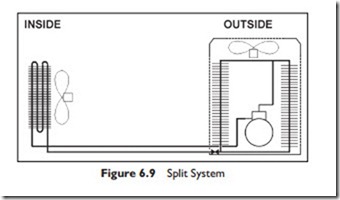Split Systems
In the rooftop unit, all the plant was in a single housing and was purchased as a manufacturer’s pre-design. In general, the package rooftop-units are designed for popular duties, and to be as light and compact as possible, since they have to be lifted onto the roof. In the split system, the compressor/ condenser part of the refrigeration system is chosen separately from the rest of the system and connected by the refrigerant lines to the air system, which includes the evaporator. The pipes, even with their insulation, are only inches in diameter, compared to ducts that are, typically, feet in diameter. The separation of the two parts of the refrigeration system to produce the split system is diagrammed in Figure 6.9. The system can range in size from the small residential systems where the inside coil is mounted on the furnace air outlet to substantial commercial units serving a building.
The split system allows the designer a much greater choice of performance. For example, designing a unit for operation in an ice rink requires a low space temperature, hence a non-package situation. This requirement is well suited to the flexibility of the split system.
The other main advantage of the split system is that it allows the air handling part of the unit to be indoors, where it is easier to maintain and does not need to be weatherproofed. The noise of the compressor is outside and can be located at some distance from the air-handling unit. For example, in a three-storey building, all the condensers can be mounted on the roof, while the air handlers are on the floor they serve. This allows the ducting to be run horizontally on each floor and only requires a small vertical duct for the refrigerant lines from the three units to the roof.
The Next Step
We have considered single zone air-conditioning systems in this chapter. We focused on rooftop and split systems. We considered the components they contain, how the components operate and some of the limitations of off-the-shelf equipment. Finally we looked at a simple choice of rooftop and spilt system and the resulting space conditions.
In the next chapter we will look at how these single zone systems can be modified to produce multi-zone systems.
